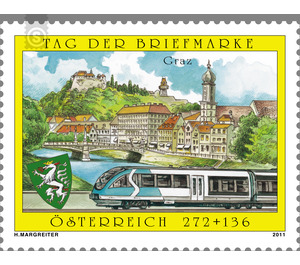day of the stamp - Austria / II. Republic of Austria 2011 - 136
Theme: Geology & Geography
| Country | Austria / II. Republic of Austria |
| Issue Date | 2011 |
| Face Value | 272.00 |
| Edition Issued | 400,002 |
| Printing Type | offset |
| Stamp Type | Semi-Postal |
| Item Type | Stamp |
| Chronological Issue Number | 2272 |
| Chronological Chapter | OOS-OE2 |
| SID | 914586 |
| In 57 Wishlists | |
This year's special stamp "Stamp Day" addresses the Styrian provincial capital Graz, the place where the ÖVEBRIA 2011, Austria's largest national competition competition exhibition, takes place from 13 to 15 May within one year. Organizer of this Rank 2 exhibition is the Organizing Committee "Marke + Münze", place of the show is the sports hall Seiersberg, which has proven itself in recent years as a venue for similar events. The motive of the additional stamp (nominal value 2.72 € + 1.36 €) shows in the foreground a set of the Graz rapid-transit railway, more exactly a motor coach of the type "Desiro" in the typical blue-white painting. The so-called "rapid-transit railway Graz" is a Styrian local transport project, on which since 1998 one works. The first commissioning took place on December 9, 2007, the completion is in the next few years, specifically until 2016, take place. In addition to the train image, there is the Styrian coat of arms, and in the background of the brand motif, the unmistakable Grazer cityscape with Schlossberg, clock tower and the Mur presents itself, a backdrop equal. With almost 300,000 inhabitants, Graz is the second largest city in Austria, the beautiful old town and castle Eggenberg have been a UNESCO World Heritage Site for many years. In addition, Graz was chosen as the city of human rights and is the bearer of the Europa Prize; With more than 40,000 students, Graz has also recently developed into a popular university city. The Old Town, where most of the sights are located, stretches across the Inner City district, but beyond its borders. In the center lies the above-mentioned Schlossberg, which served as a fortress between 1125 and 1809. (Since this was never taken, it is by the way in the Guinness Book of World Records as the strongest fortress of all time!) On the castle hill still some remains of remains and buildings from this time are preserved, among them the clock tower of 1570, the most famous landmark of Graz , the belfry and the casemates (former dungeon under the mountain). The Ferdinand bridge in front of the Schlossberg, named after Emperor Ferdinand, was the first chain bridge in Styria and the largest in Austria, built in 1836. It was renamed Keplerbrücke in 1918, in honor of Johannes Kepler, who lived and researched here for several years.


